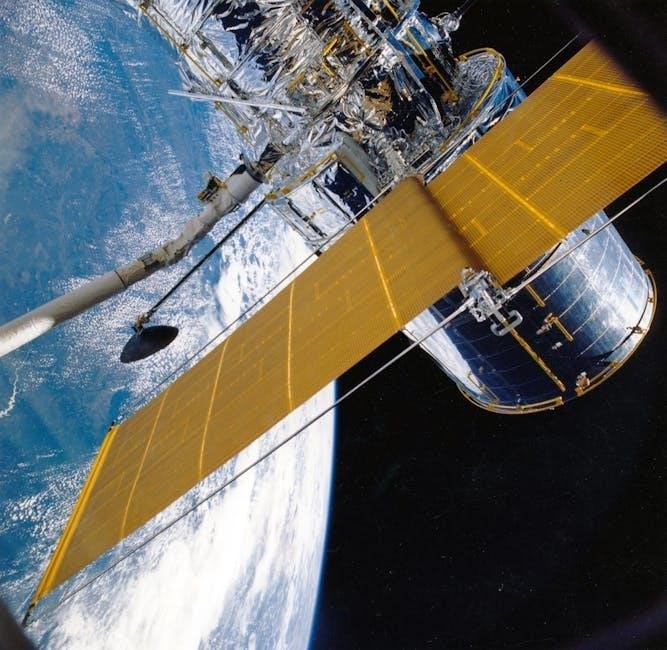Embark on a journey through the cosmos! This guide unravels the mysteries‚ from the Big Bang to quantum physics. Explore theoretical frameworks and cutting-edge concepts. Discover the building blocks that shape our expanding and ever-evolving universe. Prepare to nurture the scientist within!
Since the dawn of consciousness‚ humanity has gazed at the stars‚ wondering about our place in the vast expanse. The quest to understand the cosmos is a journey through time‚ from ancient philosophers to modern physicists. We seek answers to fundamental questions: How did the universe begin? What are its components? What are the laws that govern its behavior?
This guide serves as your starting point‚ providing accessible explanations of complex concepts. We will explore theoretical physics‚ delve into the Big Bang theory‚ and uncover the secrets of quantum physics. We’ll also examine general relativity‚ dark matter‚ dark energy‚ and the expanding universe. Prepare to be amazed by the holographic universe and the radical new approach of constructor theory.
Our journey will highlight the challenges that theoretical physicists face‚ particularly in the quest for a quantum theory of gravity. The exploration of the cosmos is an ongoing process‚ a continuous cycle of discovery and refinement. Join us as we embark on this intellectual adventure‚ unraveling the mysteries of the universe‚ one concept at a time.
Theoretical Physics: The Foundation of Our Understanding
Theoretical physics provides the framework for understanding the universe‚ constructing theories and confronting them with experiments and observations. It’s a realm where mathematical models and computational methods are used to study physical phenomena‚ making predictions about the cosmos. From the tiniest quantum realms to the large-scale structure of the universe‚ theoretical physics seeks to explain it all.
At its core‚ theoretical physics is about building self-logical theories to explain phenomena‚ offering models for understanding empirical results. It began at least 2‚300 years ago‚ evolving through the contributions of thinkers like Archimedes‚ who laid the foundations of hydrostatics. Modern theoretical physics encompasses quantum field theory‚ general relativity‚ string theory‚ and condensed matter physics.
Cosmologists use theoretical physics to study the evolution and composition of the universe‚ connecting the structure we see today to the exotic high-energy physics of the early universe. Theoretical physicists explore the fundamental principles‚ seeking a unified theory that links all aspects of the universe. It’s a quest for a single‚ all-encompassing framework‚ a journey to the heart of reality itself.
The Big Bang Theory: The Universe’s Origin Story
The Big Bang theory is the prevailing cosmological model for the universe. It describes how the universe expanded from an initial state of high density and temperature. Imagine an infinitely hot and dense single point that inflated rapidly‚ forming the ever-expanding cosmos we observe today. This expansion began approximately 13.8 billion years ago and continues to this day.
The concept of an expanding universe scientifically originated with physicist Alexander Friedmann in 1922‚ who mathematically derived the Friedmann equations. These equations provide a framework for understanding the dynamics of the universe’s expansion. The Big Bang theory is supported by a wealth of evidence‚ including the cosmic microwave background radiation and the abundance of light elements.

While the Big Bang theory explains the universe’s evolution from its early moments‚ it doesn’t fully explain what triggered the initial expansion or the nature of the singularity. It is important to note that it provides a framework for understanding the physical events that happened in the first moments of its history. Still‚ it’s a cornerstone of our understanding‚ offering a compelling narrative for the universe’s origin story.
Quantum Physics: Unveiling the Universe’s Smallest Secrets
Quantum physics delves into the bizarre world of atoms and subatomic particles‚ revealing the fundamental laws that govern the universe at its most minute scales. Unlike classical physics‚ which describes the macroscopic world with certainty‚ quantum physics introduces probabilities and uncertainties. Particles can exist in multiple states simultaneously‚ a concept known as superposition‚ until measured.
Another key concept is quantum entanglement‚ where two particles become linked in such a way that they share the same fate‚ no matter how far apart they are. This interconnectedness challenges our classical understanding of locality and causality. Quantum field theory (QFT) further expands upon quantum mechanics by incorporating fields‚ where particles are viewed as excitations of these fields.
QFT provides a framework for understanding particle creation and annihilation‚ as well as the interactions between particles through fundamental forces. While seemingly counterintuitive‚ quantum physics has led to groundbreaking technologies‚ including lasers‚ transistors‚ and medical imaging. It continues to push the boundaries of our understanding‚ offering profound insights into the nature of reality itself.
General Relativity: Gravity and the Structure of Spacetime
Einstein’s theory of general relativity revolutionized our understanding of gravity‚ moving beyond Newton’s concept of a force acting between objects. Instead‚ general relativity describes gravity as a consequence of the curvature of spacetime caused by mass and energy. Massive objects warp the fabric of spacetime around them‚ influencing the motion of other objects.

This curvature dictates how objects move‚ explaining why planets orbit stars and why light bends as it passes massive objects. General relativity predicts phenomena like gravitational lensing‚ where the gravity of a massive object bends and magnifies light from objects behind it‚ offering glimpses into the distant universe.
Black holes‚ regions of extreme spacetime curvature‚ are also a consequence of general relativity. These objects have such strong gravity that nothing‚ not even light‚ can escape their pull. General relativity has been extensively tested and confirmed through observations of the solar system‚ gravitational waves‚ and the expansion of the universe. It remains a cornerstone of modern cosmology and astrophysics‚ providing a framework for understanding the large-scale structure and evolution of the cosmos.
The Expanding Universe: Measuring the Cosmos’ Growth
The universe isn’t static; it’s expanding! This groundbreaking discovery‚ primarily attributed to Edwin Hubble‚ reshaped our cosmic understanding. By observing the redshift of distant galaxies – their light stretched towards the red end of the spectrum – Hubble concluded that these galaxies are moving away from us‚ and the farther they are‚ the faster they recede. This relationship is known as Hubble’s Law.
Measuring the expansion rate‚ quantified by the Hubble constant‚ is a key pursuit in cosmology. Scientists use various techniques‚ including observing distant supernovae and studying the cosmic microwave background (CMB)‚ the afterglow of the Big Bang. However‚ different methods yield slightly different values for the Hubble constant‚ leading to a persistent tension known as the Hubble tension.
Understanding the expansion rate is crucial for determining the age and size of the universe‚ as well as for testing cosmological models. Current research focuses on refining measurement techniques and exploring new methods to resolve the Hubble tension and gain deeper insights into the universe’s expansion history and its ultimate fate. The expanding universe is not just growing physically; it’s also expanding our knowledge.

Dark Matter and Dark Energy: The Unknown Components
The universe holds secrets beyond our direct observation! Dark matter and dark energy‚ though invisible‚ constitute the vast majority of the cosmos. Their existence is inferred from their gravitational effects on visible matter and the universe’s expansion. Dark matter‚ making up about 85% of the universe’s mass‚ doesn’t interact with light‚ but its gravity shapes galaxies and galaxy clusters.
Scientists search for dark matter particles through direct detection experiments‚ indirect detection by observing gamma rays and neutrinos‚ and by creating dark matter in particle colliders. Numerous candidates exist‚ from weakly interacting massive particles (WIMPs) to axions. Dark energy‚ even more mysterious‚ drives the accelerated expansion of the universe.
The leading theory is that dark energy is a cosmological constant‚ an intrinsic energy density of space. Alternative explanations include quintessence‚ a dynamic energy field. Understanding dark matter and dark energy is a central challenge in cosmology. Unraveling their nature will revolutionize our understanding of gravity‚ particle physics‚ and the ultimate fate of the universe‚ revealing the true composition of our cosmic home.
Quantum Field Theory: Particles and Forces
Quantum Field Theory (QFT) represents a profound shift from classical physics‚ where particles are point-like objects interacting through forces. QFT views particles as excitations of underlying quantum fields‚ permeating all of space. These fields are quantized‚ meaning their energy exists in discrete packets‚ analogous to particles. Each fundamental particle‚ like electrons and photons‚ has its corresponding quantum field.
Forces between particles arise from the exchange of force-carrying particles‚ also excitations of quantum fields. For example‚ the electromagnetic force is mediated by photons. QFT elegantly combines quantum mechanics and special relativity‚ providing a framework to describe particle interactions at extremely high energies and small distances. It is the foundation of the Standard Model of particle physics‚ which classifies all known fundamental particles and forces‚ except gravity.
QFT has been incredibly successful in predicting experimental results with high precision. It has also led to groundbreaking technologies like lasers and transistors. However‚ QFT faces challenges‚ particularly in incorporating gravity. Despite these challenges‚ QFT remains a cornerstone of modern physics‚ providing essential tools for understanding the universe’s fundamental building blocks and their interactions.
String Theory: A Potential Theory of Everything
String theory emerges as a compelling attempt to unify all fundamental forces and particles into a single‚ elegant framework‚ potentially becoming the “Theory of Everything.” Unlike the Standard Model‚ which treats particles as point-like‚ string theory proposes that the fundamental constituents of the universe are tiny‚ vibrating strings. These strings‚ far smaller than atoms‚ vibrate at different frequencies‚ giving rise to different particles and forces.
A key feature of string theory is its requirement for extra spatial dimensions beyond the three we experience. These extra dimensions are thought to be curled up at subatomic scales‚ rendering them invisible. String theory also elegantly incorporates gravity‚ addressing a major limitation of the Standard Model. It predicts the existence of the graviton‚ the force-carrying particle of gravity.
While string theory offers a promising path towards unification‚ it remains largely theoretical. It lacks direct experimental verification‚ as testing its predictions requires energies beyond our current capabilities. Despite this‚ string theory has profoundly influenced theoretical physics‚ providing new mathematical tools and insights into quantum gravity and the early universe. It is a vibrant area of research‚ with ongoing efforts to connect it to observable phenomena.
Constructor Theory: A Radical New Approach
Constructor theory presents a novel framework for understanding the universe‚ shifting the focus from laws of physics to what transformations are possible or impossible. Unlike traditional physics‚ which primarily describes what happens‚ constructor theory seeks to explain what can happen and why‚ based on fundamental principles of information and computation. This approach‚ championed by thinkers like David Deutsch and Chiara Marletto‚ offers a broader perspective on physical reality.
At its core‚ constructor theory posits that all physical processes are governed by “constructors‚” entities that can perform specific tasks without being consumed in the process. These tasks can include creating copies of information‚ catalyzing chemical reactions‚ or even building complex structures. The theory emphasizes the importance of information as a fundamental aspect of reality‚ suggesting that the ability to create and preserve information is a key characteristic of physical systems.
Constructor theory has the potential to address some of the limitations of existing physical theories‚ particularly in areas like quantum computation‚ theoretical biology‚ and the foundations of physics. By focusing on possibilities and impossibilities‚ it provides a new lens for exploring the nature of reality and the fundamental limits of what can be achieved in the universe. It’s a radical departure from conventional approaches‚ opening new avenues for scientific inquiry.
The Holographic Universe: A 2D Projection?
Imagine the universe as a giant hologram‚ where everything we perceive as three-dimensional reality is actually encoded on a distant two-dimensional surface. This mind-bending concept‚ known as the holographic principle‚ suggests that the information describing our entire universe can be contained on its boundary‚ much like a hologram is encoded on a flat piece of film. While seemingly paradoxical‚ this idea has gained traction in theoretical physics as a potential solution to some of the most perplexing questions about the nature of reality.
The holographic principle emerged from the study of black holes and quantum gravity. It was initially proposed as a way to resolve the information paradox‚ which arises from the apparent loss of information when objects fall into black holes. The holographic principle suggests that the information is not lost but rather encoded on the event horizon‚ the boundary of the black hole. This idea was then extended to the entire universe‚ leading to the holographic universe concept.
If the holographic principle is correct‚ it would have profound implications for our understanding of space‚ time‚ and gravity. It suggests that gravity is not a fundamental force but rather an emergent phenomenon arising from the underlying quantum mechanics of the two-dimensional surface. Although it is still a theoretical framework‚ the holographic universe offers a compelling and radical perspective on the nature of reality.
Challenges in Theoretical Physics: Quantum Gravity
One of the most formidable challenges in modern theoretical physics is the quest to reconcile general relativity with quantum mechanics‚ leading to a comprehensive theory of quantum gravity. General relativity‚ Einstein’s groundbreaking theory of gravity‚ describes the universe on a large scale‚ explaining the behavior of massive objects and the structure of spacetime. Quantum mechanics‚ on the other hand‚ governs the realm of atoms and subatomic particles‚ providing a probabilistic description of their behavior.
The problem arises because general relativity treats spacetime as a smooth‚ continuous entity‚ while quantum mechanics suggests that at the smallest scales‚ spacetime may be discrete and granular. When attempting to combine these two theories‚ mathematical inconsistencies and paradoxes emerge‚ particularly when considering phenomena such as black holes and the Big Bang.
Developing a consistent theory of quantum gravity is crucial for understanding the universe at its most fundamental level. Such a theory could potentially resolve some of the deepest mysteries in cosmology‚ such as the nature of dark matter and dark energy‚ and provide insights into the very beginning of the universe. Various approaches‚ including string theory‚ loop quantum gravity‚ and causal dynamical triangulations‚ are being explored in the hope of constructing a successful theory of quantum gravity.
Our exploration into constructing the universe has revealed the breathtaking scope of theoretical physics and the remarkable progress made in understanding the cosmos. From the foundational principles of quantum mechanics and general relativity to the more speculative realms of string theory and constructor theory‚ we’ve glimpsed the intricate tapestry of ideas that scientists are weaving to unravel the universe’s deepest secrets.
However‚ it’s crucial to recognize that this journey is far from over. Significant challenges remain‚ particularly in the quest for a theory of quantum gravity‚ which could unify our understanding of the large-scale structure of the universe with the behavior of matter at the smallest scales. The ongoing search for dark matter and dark energy‚ the mysterious components that make up the majority of the universe’s mass-energy density‚ also presents a formidable puzzle.
As technology advances and new experimental data becomes available‚ theoretical physicists will continue to refine their models and push the boundaries of knowledge. The universe is a vast and complex place‚ and our quest to understand it is an ongoing endeavor that requires creativity‚ collaboration‚ and a willingness to challenge existing paradigms. The adventure of constructing the universe is an open-ended story‚ and the next chapter promises to be filled with even more exciting discoveries.

Leave a Reply
You must be logged in to post a comment.